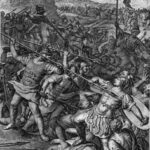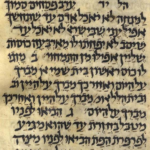One of the most frequently asked questions about the Haggadah is why the second most important character in the exodus story (after G-d!) is never even mentioned. A number of answers have been offered to this problem:
- The most famous answer is that Moshe is deliberately omitted from the Haggadah because including him would distract from the true message of the exodus story, which is that G-d alone saved the children of Israel without human help (Vilna Gaon and lots of others)
- Moshe was the the most modest of men (Bemidbar 12:3). He wouldn’t have wanted to be included in the Haggadah read by Jews every year, therefore he wasn’t. (Chofetz Chaim)
- The omission of Moshe is a response to the ‘two powers in heaven’ or logos theology that was widespread in sections of late-antique Jewry, including those from which the Christian church emerged. One trend within this theological approach was to semi-deify biblical figures as material expressions of the logos, including Moshe. The Haggadah therefore minimizes the role of Moshe to preclude such a suggestion. (David Arnow)
- The omission of Moshe is a response to Karaite versions of Seder night, which would have given a prominent role to Moshe simply as a result of following closely the biblical text.
- The Haggadah wants to use the exodus story as an archetype of geula that occurs in each generation. The near absence of Moshe is therefore a product of a tendency to shift the focus from the specifics of the story in Egypt to eternal themes of bondage and liberation. (David Henschke)
More explanations of various degrees of plausibility are listed here and here.
What unites all of the answers, however, is that they accepts the premise of the question: on Seder night we are supposed to tell the story of the exodus (which according to most authorities is a mitzvah d’oraita), the way we do this is by reading (and perhaps explaining) the words of the Maggid as they appear in the book. Since the Maggid is a retelling of the exodus story, the absence of Moshe is noteworthy and demands explanation.
But is the premise actually true? Forget all you ‘know’ and sit down and read the Maggid from beginning to end. It only takes 10 minutes. Is it actually a rendition of the exodus story? If it is, is it a good one? Isn’t it kind of weird and incoherent? Do you even have a clue what some of it means without reading a bunch of commentaries? If you had a few hours to go over the exodus story and prepare a 15 minutes rendition, couldn’t you do a better job? Couldn’t pretty much anyone?
The truth staring you in the face is that the Maggid isn’t a rendition of the exodus story at all. But what is it? The short answer is that it is a map of the exodus story that guides you through from beginning to end by breaking up the ארמי אבד אבי passage into tiny chunks and linking them sequentially to the story as it unfolds in Shemot. Once you know what you are looking for, it all makes sense and all the mysterious features of the text suddenly fall into place.
Once you understand this point, the supposed absence of Moshe isn’t a question at all. The Maggid isn’t telling a story, it’s guiding you through telling the story and in so doing you will mention Moshe whenever appropriate, no more but also no less than he is mentioned in the Torah itself.
That’s the short answer. To see the long answer, look at this introductory essay, for a deeper dive look here, or download my explanatory Haggadah, which helps you use the Maggid exactly as it was intended to be used: to enlighten and not to confuse.



Leave a Reply